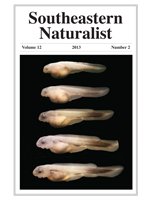Spiraea virginiana (Virginia Spiraea) is a federally threatened shrub endemic to the southern Blue Ridge and Appalachian Plateau physiographic provinces. Observations along the Cheoah River, where the largest population of S. virginiana occurs in North Carolina, indicate that Castor canadensis (Beaver) feed on S. virginiana. However, the effects of Beaver foraging on this imperiled shrub are unknown. To address this issue, we randomly located 50 belt transects (25 m × 2.5 m) along the center of the scour zone of the Cheoah River and assessed all basal stems (<2.5 cm in diameter) of woody plants for evidence of browsing by Beaver. We recorded a total of 4963 basal stems, consisting of 59 species. Of those stems, 14.7% were browsed by Beaver. Spiraea virginiana accounted for 3.5% of the total basal stems and ranked fourth in the total number of stems browsed with 8.8%. After adjusting for transect effect, S. virginiana ranked second as a preferred forage species, with 32.0% of its stems browsed. This study suggests that overall browse levels of this community are relatively low compared to other communities inhabited by Beaver because of the high-gradient and turbulent nature of the Cheoah River. Our findings provide strong evidence that S. virginiana is an important food to Beaver, and as a consequence, Beaver foraging has the potential to affect this population. Although more information is needed to determine the long-term impacts, we suspect that in the short-term, S. virginiana may benefit from the levels of browsing found in this study. Field observations suggest that Beaver foraging stimulates asexual reproduction of S. virginiana by inducing rhizomatous growth. Beaver also may help S. virginiana with dispersal, as fresh cuttings are often left at feeding sites and then may be transported downstream for rooting.
How to translate text using browser tools
1 June 2013
Impacts of Beaver Foraging on the Federally Threatened Virginia Spiraea (Spiraea virginiana) along the Cheoah River, NC
C. Reed Rossell,
Kathryn Selm,
H. David Clarke,
Jonathan L. Horton,
Jennifer Rhode Ward,
Steven C. Patch
ACCESS THE FULL ARTICLE

Southeastern Naturalist
Vol. 12 • No. 2
June 2013
Vol. 12 • No. 2
June 2013




